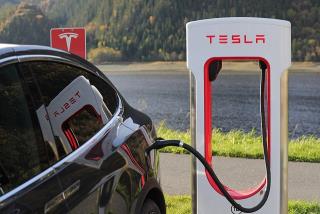
Batteries to store the excess energy that solar panels capture have advanced only slowly in the past 20 years …until now. Tesla has come up with a new approach it claims is faster cheaper and better – the Powerwall 2.
This wall or floor mounted battery pack has twice the energy of Tesla’s first generation battery, with 13.5kWh of storage. Each pack has up to a 7kWh power output, with a continuous 5kWh output on average. A liquid thermal control (coolant) system helps to regulate the internal temperature of the battery, maximising its performance. Whilst the water resistant, dust proof casing allows for outdoor or indoor installation.Up to nine of these 120kg units can be stacked together to power homes of various sizes.
Alongside these features, the Powerwall 2 has an inbuilt inverter. Not only does this save on space, it means there’s little chance of error as it doesn’t need to be hooked up to an inverter from a third party. Other battery makers such as LG Chem have to use inverters produced by other companies, making Tesla unique in this feature.
One 755mm x 1150 mm x 115 mm 14kWh Powerwall 2 battery costs $5,500 (£5,400) with installation costs starting at $1,500 (£950). Each pack comes with a 10 year warranty and the first installations are due to begin in early 2017.
Tesla is also in the process of bringing out their range of solar tiles. These come in four styles, from Tuscan to slate glass. They are opaque from the street but transparent from above, allowing the suns rays to penetrate the tile and the solar panels within to capture energy.
The use of a Powerwall 2 pack with solar panels enables homes to become self-sufficient in providing their own energy. Tesla CEO Elon Musk has a clear vision of an affordable, integrated power generation and storage system which can be rolled out across whole neighbourhoods, allowing whole streets and communities to be off-grid.
Prices of the new Tesla solar tile range are yet to be released.

2 Responses
Your article is stating that you can use the Tesla Power Wall with an off-grid system. Please can you provide evidence that this is fact. Tesla have not stated this in any of there literature and to run off-grid you would require a high voltage charging circuit.
A beautiful energy storage product indeed, but at half the price I opted for a lead acid battery bank instead! Older, tried and true technology that is just as effective as the newer lithium ion batteries, but much less expensive. I encourage others interested in learning about taking a small home offgrid to see what I am doing with a mobile, solar powered tiny house